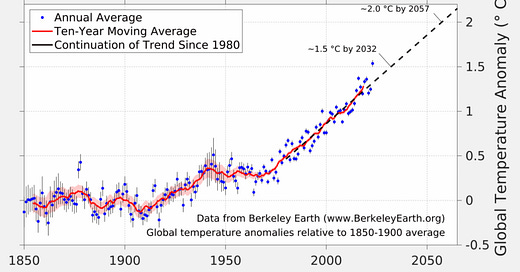AI efficiency gains for the climate
We at CLAI Ventures have a new venture fund that invests at the intersection of AI and climate. Why?
1. Earth’s temperature has already risen to 1.34℃-1.54℃ above preindustrial levels.
2. Temperature rise has significant health, societal and environmental costs, and also hinders economic output
3. Building tools that use the breakthroughs in AI for climate mitigation and adaptation will be key to human well-being
The startups at this intersection of Climate x AI range from data API unicorns like Arcadia to AI-based insurers like Kettle. From AI mining unicorns like KoBold Metals to companies like Afresh that minimize food waste by optimizing grocery inventory. There is an explosion of value creation in this software data layer of climate that has the potential to deliver outstanding venture returns and measurable impact.
The fund will invest in pre-seed to Series A rounds of software data/AI startups working on climate mitigation and adaptation. We are already deploying capital into select startups:
Aether Energy AI design and workflow software for solar installers
Powerline Grid-scale battery AI operation and bidding platform built by the first engineer on Tesla auto-bidder team
The data-AI movement that has been years in the making is finally making an impact on climate and sustainability. We are ready to catch the ripple effects of this exciting intersection.
We reached 1.34℃-1.54℃ warming in 2023
The IPCC First Assessment in 1990 highlighted warming over 1.3℃ above preindustrial levels could be associated with significant environmental changes. Fast forward to 2015, COP21 established the 1.5℃ benchmark to effectively draw a line in the sand. Unfortunately, we have already reached 1.34℃-1.54℃ levels based on a range of estimates from NOAA to Berkeley Earth.
Figure from https://berkeleyearth.org/global-temperature-report-for-2023/
The last nine years, including 2023, have been the warmest years in the instrumental record, indicating a clear long-term trend towards higher global temperatures.
Cost of 1℃ warming
Economic costs. A warming planet has costs. An MIT and Northwestern economist recently published a working paper to quantify the impact of warming planet on economic output. The takeaway point is that a 1℃ increase in global temperature, over 6 years, would cause a global 12% GDP reduction. There is reason to believe that the causal link between temperature increase and economic impact is more than linear based on the presence of positive feedback loops, so a 2℃ increase would imply a greater than 24% GDP reduction.
Environmental costs. Global temperature increases are strongly correlated to extreme weather events – wind speeds, precipitation, and temperature. Climate change has far-reaching impacts beyond changes in weather patterns. Additional environmental impacts include rising sea levels, melting glaciers, ocean acidification, and disruptions to ecosystems and agriculture.
Health and societal costs. There will also be substantial impacts on human health including disease spread, heat-related illnesses, food and water insecurity. Climate change could cause mass human migrations and lead to political unrest.
Addressing climate change requires i) mitigation: reduction of emissions, drawdown of existing atmospheric emissions, and also ii) adaptation: harnessing technology to enhance climate resilience and adaptation efforts. The stakes are high, but the potential benefits of tackling this challenge are immense.
Climate Transition lines up with the AI transition
Fortunately for us, the climate transition lines up with the wave of AI and data. Never before has there been so much data generated and so much processing ability to make sense of it. AI technologies can help us find efficiencies that will slow or hopefully even reverse climate change. AI and software-based startups align well with the time horizon and scaling requirements of venture-backed startups. This makes them attractive investment opportunities.
There are two key drivers for this next generation of Climate x AI startups:
Data available from distributed energy resources (solar, wind, storage) and utilities: At a most fundamental level, this data can be used by AI to optimize the dispatch of energy and the location of resources to create greater energy security. Essentially flattening the “duck curve.”
Geosensing data now accessible at every higher frequency and lower cost: This can be used by AI to compress or at least significantly enhance the physics-based models to make better climate predictions. These models will inform how we insure and protect people and property, where we grow food most sustainably, and how we change our shipping routes.
The applications of AI to climate can be viewed in the framework below:
Pink: Powered by data from distributed energy resources and utilities
Blue: Powered by geosensing data
Yellow: Powered by classic computer vision
Green: Powered by innovations in Large Language Models (LLM’s)
CLAI’s core mission is to apply AI to build resilience in communities to climate change along 4-dimensions that we call “Predict, Protect, Optimize, and Insure”:
Predict: AI forecasts floods and fires to minimize damage
Protect: AI integrates renewables for energy security in vulnerable areas
Optimize: AI manages water and resources for food security and saves energy in HVAC
Insure: AI provides and streamlines climate insurance
Please reach out to us at team@clai.vc if this resonates with your climate mission!





